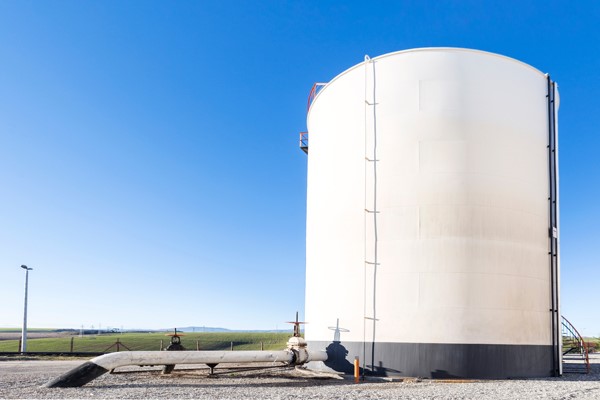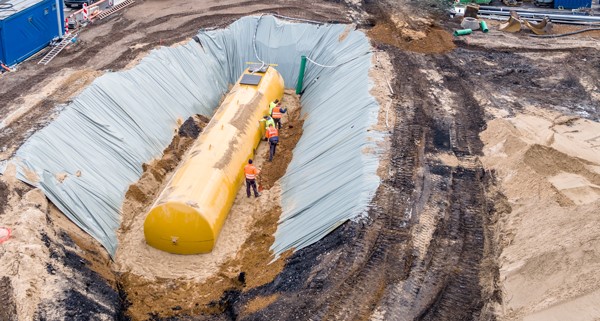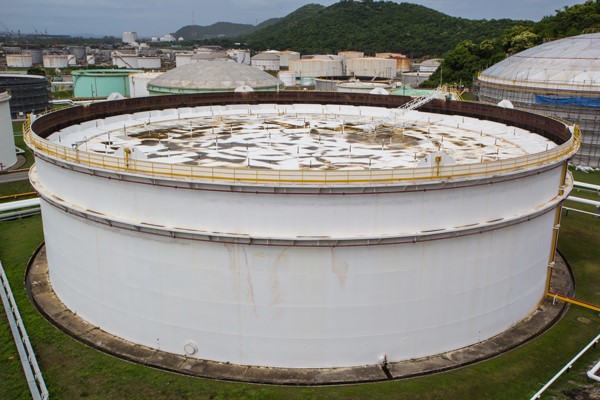What is an oil and gas storage tank? Type, Standards and Principles
An oil storage tank is a container or tank that temporarily stores oil in various stages of processing into other oil products or before use or consumption. Based on location, oil storage tanks can be classified into surface or above ground, semi-underground and underground or underground tanks.
The structure and materials of oil storage tanks depend on their intended use and the environmental conditions, safety and other legal requirements at the storage location.
Oil storage tank materials
Oil storage tanks usually consist of the following:
- Steel – Oil storage tanks made of steel are the cheapest option. The most exciting part about these tanks is that they can be used for both underground and above ground storage.
- Fiberglass – Fiberglass tanks are tough and durable. The best part about these tanks is that they are rust, leak and sediment resistant. These tanks are also available in two types of underground and above ground storage tanks.
- Composite – These are double-walled oil tanks that offer a solid and reliable storage option. According to experts, if you are looking for a rust-resistant tank, these tanks are a great option. The best part about these tanks is that they are fully compliant with pressure tests and construction standards.
Where is oil and gas stored?
Natural and industrial oil and gas can be stored underground and underground. Each option has its own set of features and benefits. The choice depends on how the repository will be used now and in the future.
Above ground oil and gas storage
As the name suggests, these storage tanks are above ground. They contain gases in either liquid or gaseous form. They remain a great option when you’re dealing with a tight construction budget. This reduces the costs associated with deep excavation, filling and pavement construction for pipelines.
Fuel tanks on the ground are also useful when you want to store gas temporarily before shipping.

Underground oil and gas storage
It is not unusual to store oil and gas underground. This move helps ensure safety and maximize space on site. It also allows you to store fuel tanks at high pressure because the weight of the soil provides the required stability of the structure.
Because products and materials are protected from environmental factors, they last longer when stored in an underground tank. You can find them scattered around man-made reservoir farms, and they provide backup when supplies run low.
Underground tanks often store hazardous liquids and gases, which is why they must meet all requirements specified by the Environmental Protection Agency (EPA). Inspections are not performed frequently, which increases the possibility of leaks and defects. Fortunately, the probability of an explosion is low.

Types of industrial gas and oil tanks
Industrial and natural gas tanks are produced in various shapes and sizes. They range from small 25-gallon tanks to large underground units that hold millions of gallons of gas and fuel. Before you start looking for equipment, consider the following factors:
- Application of the tank
- Tank capacity
- Your budget vs. tank price
Once you’ve found the answers, consider the following repository options:
Fixed roof tanks
Fixed roof tanks are usually cylindrical and the fixed roof is attached to the shell. These tanks have pressure-vacuum valves and valves to maintain ambient pressure (0.5 PSI).
These storage tanks can hold any liquid, be it gasoline, diesel or chemicals.
Floating roof tanks
The tank has a roof that floats directly over its contents. While a floating roof tank stores most liquids, it is widely used in the petroleum products industry.
The biggest advantage of a floating roof tank is the vapor management of volatile compounds (VOCs) and other air pollutants. Floating roof tanks improve overall safety and reduce the risk of product loss.
The two types of floating roof tanks are:
- External Floating Roof Tanks (EFR) – These tanks expose the contents to the atmosphere at the rim or area between the tank shell and the floating roof.
- Indoor Floating Roof Tanks (IFR) – Indoor floating roof tanks allow you to store low melting point liquids like gasoline or ethanol and even gases. A floating roof is inside an external fixed roof (often conical).
The floating roof moves up or down depending on the level of the contents of the tank. When the level is low, the roof rests on stilts inside the tank.

Pressure tanks (high pressure tanks)
Pressure vessels and pressure vessels are often used interchangeably. However, there is a big difference between the two. While pressure vessels have a maximum allowable operating pressure (MAOP) of 15 PSI, pressure vessels can withstand up to 3000 PSI (and more under special regulations).
Used in a wide range of industries, pressure vessels can store petroleum products, liquefied gases and water. All high pressure vessels are covered by the ASME Boiler and Pressure Vessel Code. This code regulates the design, construction, materials, testing and quality certification of pressure vessels.

Bullet tanks
Bullet tanks are either spherical or horizontal cylindrical with rounded ends (like bullets). These above-ground tanks are ideal for storing liquid gases such as butane and ammonia, which have very low melting points.
This tank stores gases and liquids below -148 degrees Fahrenheit, ranging from 5,000 to 30,000 gallons. Pellet tanks can hold fuel with other additives that may be required to run an industrial plant.

LNG storage tanks
LNG tanks store liquefied natural gas at a very low temperature (-162 degrees Celsius). These storage tanks have an inner shell that holds the gas and an outer shell that holds the insulation. LNG storage tanks release vapors periodically to prevent temperature and pressure increases and blowouts.
Difference between CNG and LNG
- While compressed natural gas (CNG) is often confused with liquefied natural gas (LNG), it is important to note the difference.
- Compressed natural gas is stored at ambient temperature and high pressure.
- Liquid natural gas is stored at low temperature and ambient pressure.
CNG storage is cheaper because it does not require temperature control and double-walled tanks. Trains, ships and pipelines transport natural gas over long distances in the form of LNG and convert it to CNG before distributing it to customers.
Safety features
- Non-slip stair materials on stairs and catwalks
- Rail and catwalk “safety yellow” for high visibility
- Safe operation reminder labels
- Safety side staircase – no mechanical guardrail to install
- Strapping diagrams
Testing and quality control
There is no room for error when it comes to our products. That’s why our manufacturing process is overseen by an in-house QC department that ensures our personnel get every tank done right the first time, every time.
Hydrostatic testing is a method of testing a completed reservoir before placing oil or gas. As the name suggests, this test requires the tank to be filled with water. Hydrostatic testing is primarily a structural leak test.
Depending on the type of tank you need, our comprehensive testing and completion may also include:
- Visual inspection and step-by-step monitoring of all processes to ensure the best possible quality
- Radiographic test (RT)
- Ultrasonic test (UT)
- Paint Penetration Test (PT)
- Magnetic particle test (MT)
- Heat treatment and stress reduction
- Hardness test
- Impact test
- Identification of positive substances (PMI)
- Leak test
- Soluble salt test
- Measurement of complete blast profile and lining
- Dry layer thickness test
- Adhesion test
- Coverage continuity test (holidays).
Thermal protection for gas storage tanks
If you are ordering a low pressure LPG or LNG tank, then thermal protection is important to keep the gas cool and prevent the tank from over pressurizing.
Improper insulation of the storage tank can lead to leakage, and if a crack or leak appears in the LPG tank, it can lead to an explosion, causing huge economic losses and loss of personnel.
If you need an LPG or LNG storage tank, T BAILEY INC engineers will design your tank with the best possible thermal protection. Depending on the product stored in your tank, our thermal insulation can be made of steel, aluminum, corrugated metal or flat plate metal. INSULATION T BAILEY INC. Always optimized to prevent corrosion and water damage.
If necessary, we can also build heating coils into the tank that help bring the tank contents to a temperature that will be properly stored or transported. Steam is one of the methods used to heat the product and it can be passed through the coils. We also use an electric heater. It may be necessary for your tank if you plan to store crude oil or similar materials.
